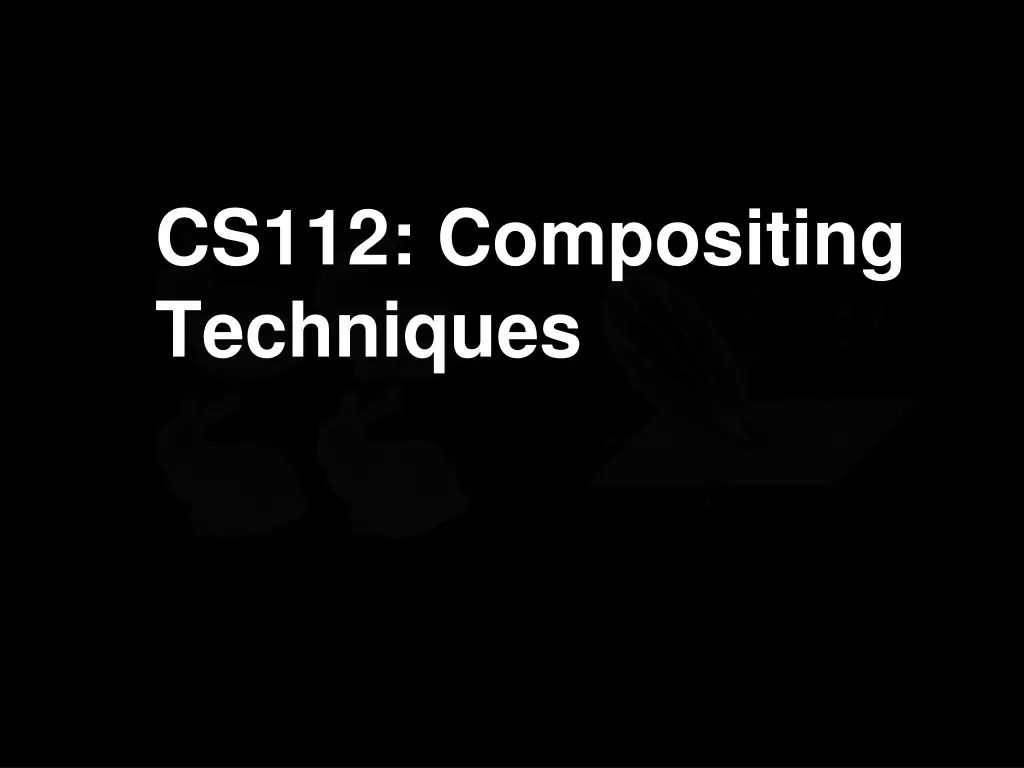
Understanding Compositing Techniques in Graphics
Learn about compositing techniques in graphics, including the alpha channel, compositing functions, transparency, and the importance of order in rendering opaque and translucent objects. Gain insights into blending colors, handling transparency, and the impact of render order on the final image.
Download Presentation

Please find below an Image/Link to download the presentation.
The content on the website is provided AS IS for your information and personal use only. It may not be sold, licensed, or shared on other websites without obtaining consent from the author. If you encounter any issues during the download, it is possible that the publisher has removed the file from their server.
You are allowed to download the files provided on this website for personal or commercial use, subject to the condition that they are used lawfully. All files are the property of their respective owners.
The content on the website is provided AS IS for your information and personal use only. It may not be sold, licensed, or shared on other websites without obtaining consent from the author.
E N D
Presentation Transcript
CS112: Compositing Techniques
Announcements PA2 will be due next week Please start early and use Piazza for discussions! Friday s discussion sessions No official presentations You are encouraged to attend to get TA time! 2
The Alpha Channel In addition to RGB, the fourth color channel Used for alpha blending GL_BLEND in OpenGL Application can control the value of alpha at every pixel (the same way as for RGB) 3
Compositing Functions Source color: associated with the current fragment S = [sr, sg, sb, sa] Destination color: associated with a pixel in the frame buffer D = [dr, dg, db, da] When a fragment with color S is written into a pixel with color D in the frame buffer, the pixel color changes to: D = fs(sa,da) S + fd(sa,da) D Compositing function Compositing function 4
Transparency D = saS + (1 - sa)D fs(sa,da) = sa(GL_SRC_ALPHA) fd(sa,da) = 1 - sa(GL_ONE_MINUS_SRC_ALPHA) Color of the fragment being rendered is scaled by sa Color existing in the framebuffer scaled by (1 - sa) Opaque fragments have sa= 1 Framebuffer gets overwritten Transparent fragments have sa= 0 Framebuffer remains unchanged Translucent fragments have 0 < sa< 1 Color gets blended 5
Transparency Chicken = 1, Egg = 0 Chicken = 0.5, Egg = 0.5 Chicken = 0, Egg = 1 6
Order Matters A: opaque (alpha = 1) B, C: transparent (alpha < 1) A blocks B and C, wrong! A 3 B 1 C 2 Image Plane 7
Order Matters A: opaque (alpha = 1) B, C: transparent (alpha < 1) B leaks through A, wrong! B 3 A 1 C 2 Image Plane 8
Order Matters Render opaque objects first (occlusion resolved) Render translucent objects from back to front B 2 A 1 C 3 Image Plane 9
Order Matters Render opaque objects first (occlusion resolved) Set depth buffer to read-only Retains the depth of opaque objects only Render translucent objects from back to front Only for fragments passing the depth test (i.e., not behind any opaque objects) 10
Results 11
Other Compositing Functions [learnopengl.com] Shuang Zhao, CS112 12
CS112: Projective Textures Shuang Zhao Assistant Professor of Computer Science University of California, Irvine
Project a texture on 3D object 3D object Viewer Texture Point of projection 14
Multi-Pass Rendering Projective textures are used to achieve complicated visual effects like: Textured illumination (i.e., virtual projector) Shadows Generally requires more than one rendering passes Output of one pass is used in successive pass or passes 15
Designing Theatres Simulate what the viewer sees Texture map screen using projected texture from projector Render the screen from the viewer Screen Projector Viewer 16
Shadows Key idea: points visible to the eye but invisible to the light are in shadow In contrast, points visible to both the eye and the light receives direct illumination and are not in shadow [learnopengl.com] 17
Shadow Mapping B is not getting light and hence in shadow B How to achieve the effect? Shadow mapping A Viewer Light 18
Rendering Pass 1 Render the scene from light ZL= The depth buffer gives the depth of the points that are lit Save the depth buffer Need to use frame buffer objects (FBO) in OpenGL B A Viewer Light 19
Rendering Pass 2 Render from the eye For each surface point (visible from the eye), compute its depth when viewed from the light source How? (Using the light s projection transformation) Compare this depth with the stored one from Pass 1 > stored depth, shadow = stored depth, lit B A Viewer Light 20
Results With shadow No shadow 21
Shadow Mapping Remarks Creates hard shadows Fast but not very accurate: shadows can look pixelated when the shadow map has insufficient resolution Prefiltering the shadow map helps reducing such artifacts 22
